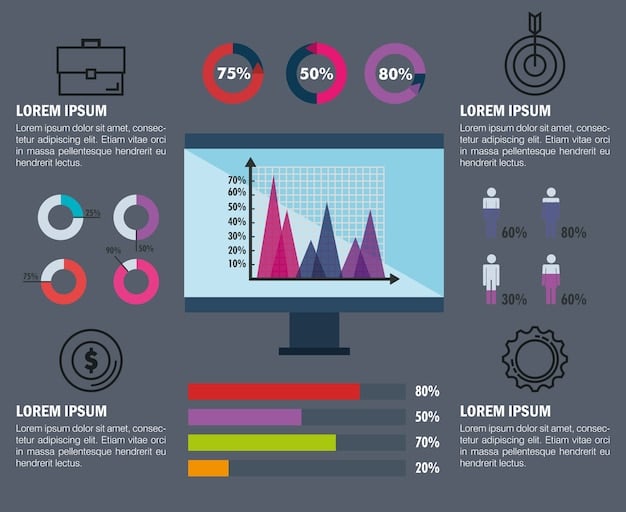E-commerce Platform Analytics: Boost US Performance by 25%

E-commerce platform analytics are crucial for US businesses aiming to improve performance; by tracking key metrics such as conversion rates, customer acquisition cost, and average order value, companies can optimize strategies to achieve a 25% increase in efficiency and revenue.
Navigating the competitive landscape of e-commerce in the US requires a deep understanding of performance metrics. Implementing robust e-commerce platform analytics: tracking the right metrics to improve your US e-commerce performance by 25% can provide actionable insights, helping businesses optimize their strategies for increased efficiency and profitability.
Understanding the Importance of E-commerce Analytics
E-commerce analytics is the backbone of any successful online business. It provides valuable data-driven insights that can inform strategic decisions and drive growth. Without a clear understanding of key performance indicators (KPIs), businesses are essentially operating in the dark, making it difficult to identify areas for improvement.
For businesses operating in the US, leveraging e-commerce analytics is particularly crucial due to the highly competitive market. By tracking the right metrics, companies can gain a competitive edge and optimize their strategies for maximum impact.
Why Analytics Matter for US E-commerce
The US e-commerce market is dynamic and constantly evolving, making it essential to stay informed about customer behavior, trends, and performance. Analytics provide the necessary data to adapt and thrive in this environment.
Key Benefits of Data-Driven Decisions
Data-driven decisions lead to more effective marketing campaigns, improved customer experiences, and increased sales. Businesses can allocate resources more efficiently by focusing on strategies that yield the highest returns.
- 📊 Identify trends and patterns in customer behavior.
- 🎯 Optimize marketing efforts to attract the right audience.
- 💰 Improve conversion rates and increase revenue.
- 🤝 Enhance customer satisfaction and loyalty.
Ultimately, understanding the importance of e-commerce analytics sets the stage for tracking the right metrics and achieving significant performance improvements in the US market. By using data to make informed decisions, businesses can stay ahead of the competition and drive sustainable growth.
Identifying Key Performance Indicators (KPIs) for E-commerce
Key Performance Indicators (KPIs) are essential metrics that help businesses evaluate their success in achieving specific objectives. In the context of e-commerce, tracking the right KPIs is crucial for identifying areas of strength and weakness, and for making data-driven decisions.
Focusing on relevant KPIs allows businesses to monitor their performance closely, identify trends, and implement strategies to improve their bottom line. These metrics provide a clear picture of how well the business is performing across different areas.

Essential E-commerce KPIs
Several KPIs are particularly important for e-commerce businesses. These metrics provide insights into customer behavior, marketing effectiveness, and overall business performance.
Tracking Metrics for Optimized Performance
By carefully tracking these KPIs, businesses can gain a deeper understanding of their performance and identify opportunities for improvement. Regular monitoring and analysis are essential for driving growth.
- 📈 Conversion Rate: Percentage of website visitors who make a purchase.
- 🛒 Average Order Value (AOV): Average amount spent per order.
- 💰 Customer Acquisition Cost (CAC): Cost of acquiring a new customer.
- 💯 Customer Lifetime Value (CLTV): Predicted revenue a customer will generate during their relationship with the business.
Identifying and tracking these KPIs allows businesses to make informed decisions, optimize their strategies, and drive significant improvements in their overall e-commerce performance. Regular analysis of these metrics is essential for sustained growth and success.
Implementing E-commerce Analytics Tools
Implementing the right e-commerce analytics tools is essential for gathering and analyzing data effectively. These tools provide businesses with the capabilities to track KPIs, monitor performance, and gain actionable insights.
Choosing the right tools can significantly impact the accuracy and depth of your analytics. Understanding the different types of tools available and their specific features is crucial for making an informed decision.
Popular Analytics Platforms
Several analytics platforms are widely used in the e-commerce industry. Each platform offers unique features and capabilities to help businesses track and analyze their performance.
Integrating Tools for Comprehensive Analysis
Integrating multiple tools can provide a more comprehensive view of your e-commerce performance. Combining data from different sources allows for a more holistic analysis.
- 🔗 Google Analytics: Track website traffic, user behavior, and conversion rates.
- 📈 Adobe Analytics: Advanced analytics platform with robust reporting features.
- 🔥 Mixpanel: Focus on user behavior and product analytics.
- ✉️ Email Marketing Platforms (e.g., Mailchimp): Track email campaign performance and customer engagement.
Implementing the right e-commerce analytics tools enables businesses to gather and analyze data effectively, leading to better-informed decisions and improved performance. Integrating multiple tools can provide a comprehensive view of performance, driving significant growth.
Analyzing and Interpreting E-commerce Data
Analyzing and interpreting e-commerce data involves turning raw data into actionable insights. This process requires a deep understanding of the metrics being tracked, as well as the ability to identify trends and patterns.
Effective data analysis can reveal areas for improvement, highlight successful strategies, and inform future decisions. It’s about understanding the story behind the numbers and using that knowledge to drive growth.
Techniques for Data Analysis
Various techniques can be used to analyze e-commerce data, each providing unique insights. These techniques help businesses understand different aspects of their performance.
Turning Insights into Actionable Strategies
The ultimate goal of data analysis is to turn insights into actionable strategies. This involves identifying specific areas for improvement and implementing changes to drive positive results.

- 🔍 Segmentation: Divide customers into groups based on demographics, behavior, or purchase history.
- 🎯 A/B Testing: Experiment with different versions of a webpage or marketing campaign to see which performs better.
📊 Trend Analysis: Identify patterns and trends in data over time.
💰 Cohort Analysis: Group customers based on when they made their first purchase and track their behavior over time.
Analyzing and interpreting e-commerce data is critical for turning raw information into actionable strategies. By understanding the story behind the numbers, businesses can identify areas for improvement, optimize their efforts, and drive significant growth.
Optimizing User Experience based on Analytics
Optimizing user experience (UX) based on analytics is critical for improving customer satisfaction and conversion rates. By analyzing user behavior, businesses can identify pain points and make changes to enhance the overall shopping experience.
A positive UX leads to higher customer engagement, increased sales, and improved brand loyalty. Understanding how users interact with your website is essential for making data-driven improvements.
Analyzing User Behavior
Analyzing user behavior involves tracking how visitors interact with your website. This includes monitoring page views, bounce rates, time on site, and navigation patterns.
Making Data-Driven Improvements
Based on the insights gained from analyzing user behavior, businesses can make data-driven improvements to their website’s design, navigation, and content. These changes can significantly enhance the user experience.
- 🎨 Improve Website Design: Ensure the website is visually appealing and easy to navigate.
- 📱 Mobile Optimization: Ensure the website is responsive and works well on mobile devices.
- ✍️ Enhance Content: Provide clear, concise, and engaging content.
🚀 Optimize Site Speed: Fast loading times are crucial for user satisfaction.
Optimizing UX based on analytics is crucial for creating a seamless and enjoyable shopping experience, ultimately leading to improved customer satisfaction and higher conversion rates. By understanding user behavior and making data-driven improvements, businesses can drive significant revenue growth.
Enhancing Marketing Strategies with Analytics
Enhancing marketing strategies with analytics is essential for maximizing the return on investment (ROI) of marketing campaigns. By tracking the performance of different marketing channels, businesses can identify which strategies are most effective and allocate resources accordingly.
Data-driven marketing leads to more targeted campaigns, higher conversion rates, and improved customer acquisition costs. Understanding the impact of your marketing efforts is essential for driving growth.
Tracking Marketing Channel Performance
Tracking the performance of different marketing channels involves monitoring metrics such as click-through rates (CTR), conversion rates, and cost per acquisition (CPA). This data provides insights into the effectiveness of each channel.
Optimizing Campaigns for Higher ROI
Based on the data gathered, businesses can optimize their marketing campaigns to achieve a higher ROI. This involves adjusting ad spend, refining targeting, and improving ad creative.
- 📢 Email Marketing: Track open rates, click-through rates, and conversion rates to optimize email campaigns.
- 🔥 Search Engine Optimization (SEO): Monitor keyword rankings, organic traffic, and conversion rates to optimize SEO efforts.
- 🎯 Paid Advertising (PPC): Track click-through rates, conversion rates, and cost per acquisition to optimize PPC campaigns.
💰 Social Media Marketing: Analyze engagement, reach, and conversion rates to improve social media strategy.
Enhancing marketing strategies with analytics leads to more effective campaigns, higher conversion rates, and improved customer acquisition costs. By making data-driven decisions, businesses can maximize their marketing ROI and drive significant growth.
| Key Metric | Brief Description |
|---|---|
| 📈 Conversion Rate | Percentage of visitors who make a purchase. |
| 🛒 Average Order Value | Average amount spent per order. |
| 💰 Customer Acquisition Cost | Cost of acquiring a new customer. |
| 💯 Customer Lifetime Value | Predicted revenue a customer will generate. |
Frequently Asked Questions
▼
Key metrics include conversion rate, average order value (AOV), customer acquisition cost (CAC), and customer lifetime value (CLTV). Tracking these metrics helps businesses understand performance and identify areas for improvement.
▼
To improve your conversion rate, focus on optimizing user experience, enhancing website design, ensuring mobile responsiveness, and providing clear and compelling product information. A/B testing can also help.
▼
Popular tools include Google Analytics, Adobe Analytics, and Mixpanel. Email marketing platforms like Mailchimp also provide valuable data. Integrating multiple tools provides a comprehensive view of performance.
▼
Analytics help track the performance of different marketing channels, identify effective strategies, and optimize campaigns for higher ROI. This involves adjusting ad spend, refining targeting, and improving ad creative.
▼
CLTV helps businesses understand the long-term value of their customers. By focusing on increasing CLTV, companies can improve customer retention, loyalty, and overall profitability, maximizing their investment in customer relationships.
Conclusion
In conclusion, leveraging e-commerce platform analytics is paramount for US businesses striving for enhanced performance. By tracking the right metrics, implementing appropriate tools, and optimizing strategies based on data-driven insights, companies can effectively improve their e-commerce performance and achieve a significant 25% boost.





